starts Doing Long Stokes With One Hand Continuing to Tug Towards the Bottom With the Other
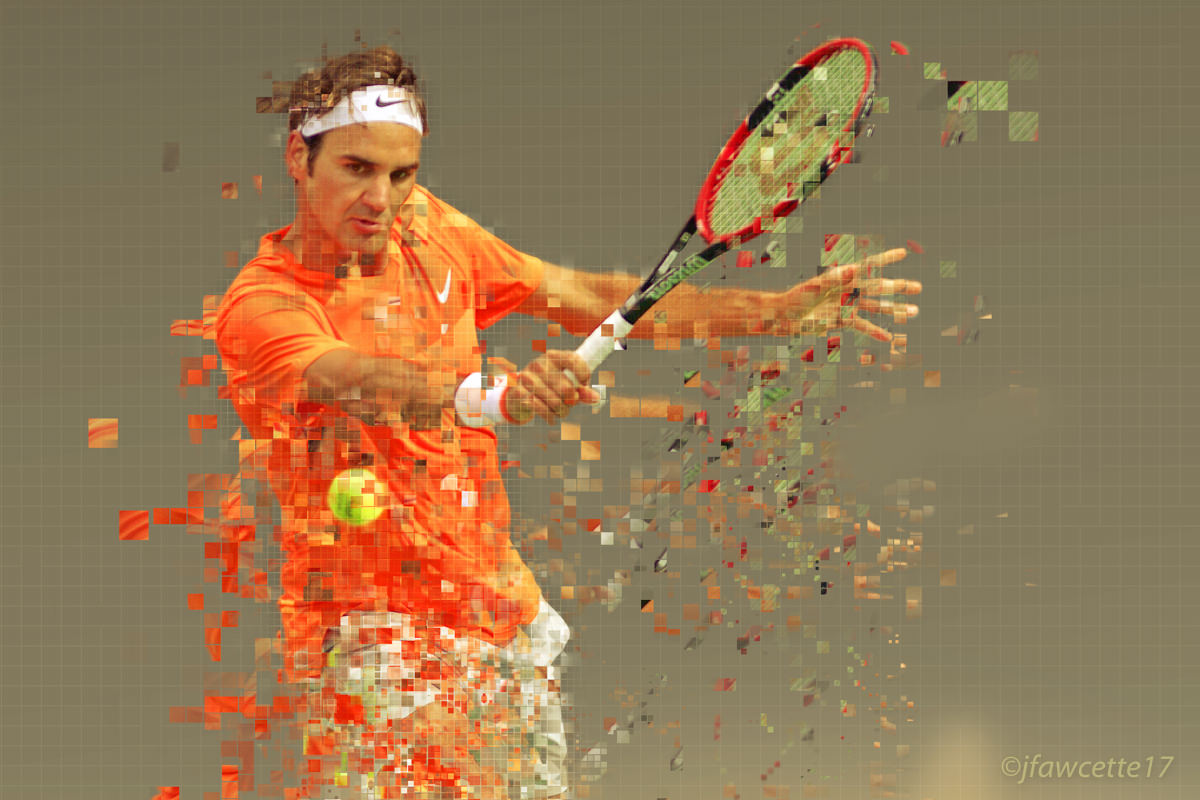
Photo: ©jfawcette
If you're new to tennis you'll probably agree that:
Tennis terminology and the various strokes can get confusing for a beginner. There are so many terms, definitions, rules, and shots that if you haven't grown up playing or watching the sport it can all feel a little overwhelming.
Since I began sharing tennis tips and instructions on my YouTube channel, Coaching App and newsletter I've received a lot of elementary questions from people who have just picked up a racquet for the first time.
Realising that not everyone knows the basics of how to hit a tennis ball or even what a "groundstroke" is I've decided to write this introductory guide on the basic tennis strokes, terms and definitions. For each stroke I have also included a simple breakdown on how to perform it.
If you're a long time fan or player much of this article will seem painfully obvious to you. But this blog post is for total beginners who want to learn the fundamentals of the sport, understand basic terms, and become familiar with the six core strokes in tennis.
Here is what I'll be covering in this introductory guide. Each section contains an overview and step-by-step instructions:
- 6 basic tennis strokes
- The basic mechanics of tennis
- The serve
- Ground strokes: forehand and backhand
- Volleys: Forehand volley & backhand volley
- Overhead smash
- Next steps
Alright, let's dive into it starting with a brief overview of the core mechanics and fundamental technical principles that apply to all strokes in tennis:
6 Basic Tennis Strokes.
All games of tennis consist of six basic strokes: the serve, forehand groundstroke, backhand groundstroke, forehand volley, backhand volley, and the overhead smash.
The 6 basic "strokes" are the fundamental movements a player performs to hit a tennis ball. A "shot" on the other hand is what happens as a result of a stroke. For example:
- Forehand groundstroke = stroke
- Inside out topspin forehand winner = shot
The difference is subtle but important. Especially if you're a beginner looking to learn and understand the game. But all you really need to know is that every single shot like a lob or drop shot, regardless of the spin used, comes from one of the six fundamental strokes.
The basic mechanics of tennis.
All strokes in tennis are a sequence of motions referred to as a "kinetic chain". It begins at a player's feet, extending through the legs, hips, chest, shoulders, arm, and wrist to the racquet as it impacts the tennis ball. This kinetic chain or kinetic linkage as it's often called allows the build up, storage, and transfer of energy to generate power for your shot.
What does all this mean?
Essentially it means you want all parts of your body to work together and in harmony. In other words the correct amount of rotation, up/down movement, side-to-side movement, and forward/backward momentum will result in the best possible tennis technique.
So now that you understand the basic technical principles let's move on the the six core strokes starting with the most important shot in tennis:
Tennis serve definition, overview and rules.
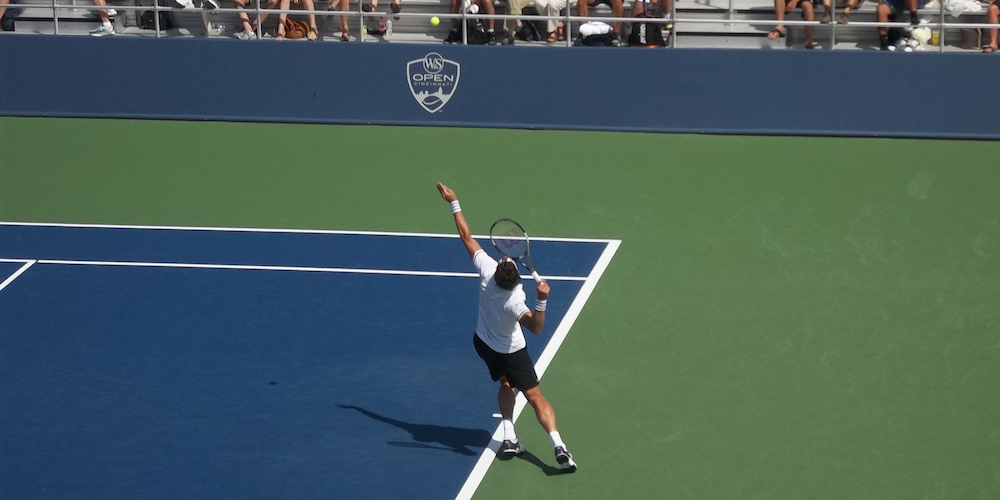
So what is a serve? A serve in tennis is the stroke used to start every point in a match. It is the only stroke in tennis that a player has complete control over and is therefore one of the most important shots in the game. A good serve allows the player serving to assert some control over how the point unfolds. This is because the server gets the first strike and based on the power, spin and shot placement can limit what the returning player can do.
The first point of any game or tiebreak the serving player (server) must stand behind the baseline to the right side of the centre mark when facing the net (deuce/first court). For the second point of a game or tiebreak the server stands to the left of the centre mark (ad/second court). Subsequently, for each point of the same game the serving positioning is the opposite of the previous point.
For both deuce and ad court start positions the server has two chances to hit the ball over the net and into the diagonally opposite service box. If a player misses their first serve they have another opportunity with a second serve. If a player misses their second serve it's a fault and they lose the point.
If a serve touches the net but still lands in the correct service box it is considered a let and the server gets another try. If the serve touches the net and does not land in the service box it's out and the server loses the point or proceeds with their second serve.
Beginner tips: How to serve step-by-step.
Before starting, make sure you're standing behind the baseline. Next place your feet in a side on stance where if you drew an arrow between the tips of your feet it'd point towards your opponent (this may feel a little strange at first but will help with power). Finally, grip the racket in your dominant hand using a continental grip (like you'd hold a hammer) and hold the tennis ball in your non-dominant hand. Now you're ready to start serving.
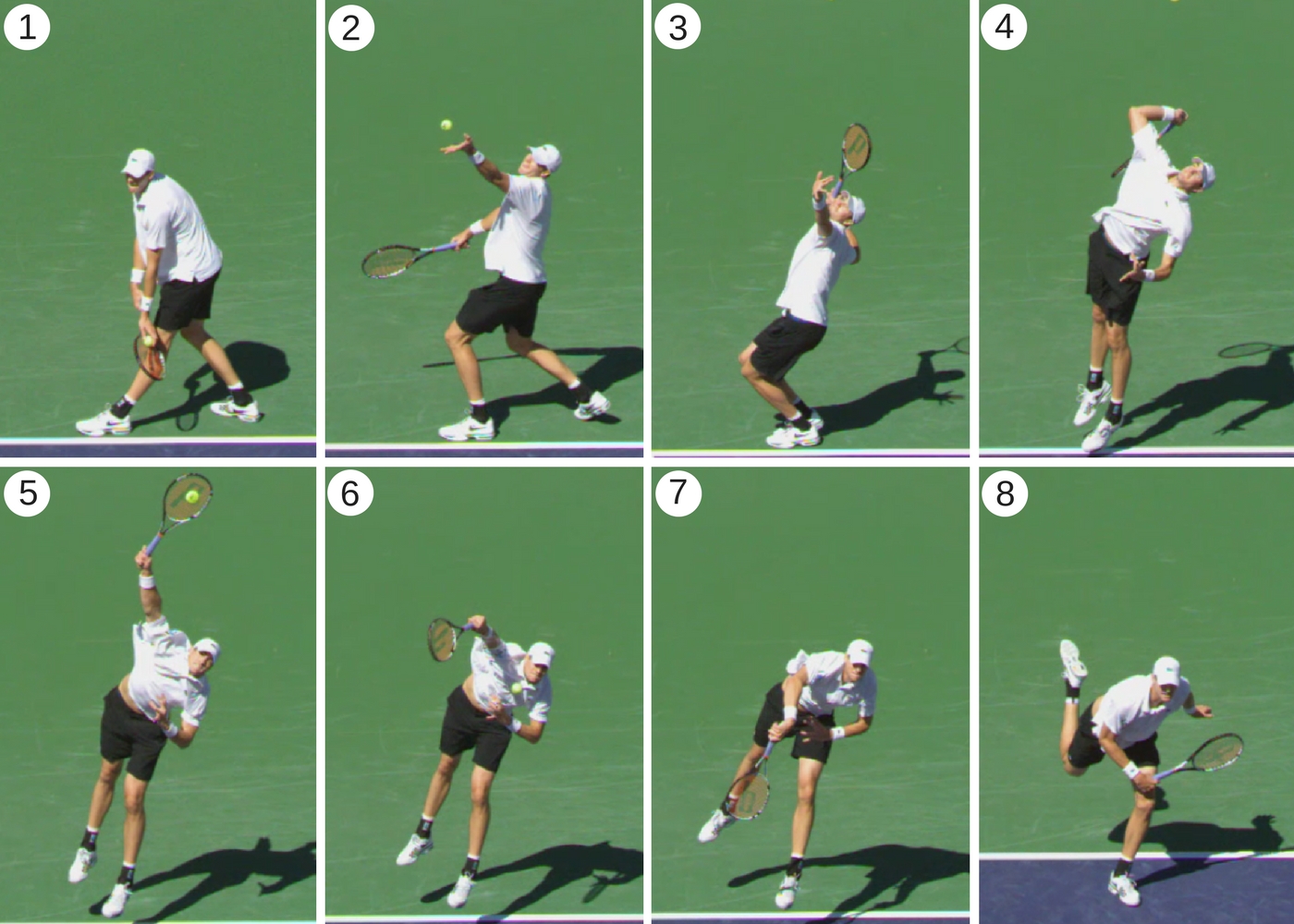
Below are eight simple step-by-step beginner tennis tips for developing a consistent serve capable of generating power and spin. For the purpose of this instruction I'll assume you're right handed. Without further ado here is how to serve in eight steps:
- Begin your service motion by holding your racket and ball in front of you.
- Start your momentum forwards by leaning towards the opponent, toss the ball in the air with your non-dominant arm while dropping your racket arm straight back. The ball toss and backswing happen simultaneously.
- Now your body should be in a ready position, fully coiled and ready to unload.
- As the ball moves into striking position above your head start uncoiling by driving up through your legs, rotating your body, and pulling your non-dominant arm down.
- Continue extending and uncoiling as your racket arm whips up and around following the rest of your body.
- At this stage your body and head position should be facing or almost facing the net as you pull down and make contact with the tennis ball.
- As you continue the follow through your body should be falling forward and to the left as your racket arm whips through the ball and slightly to the right.
- Finally, as you finish your serve motion you'll land on your left foot in in the court while your dominant arm finishes it's swing on the left side of your body (if you're right handed).
The serve is one of the most technically complex strokes in tennis which is why many players struggle with it. A few more general pointers to help you on your way is to A) stay relaxed, B) keep your technique simple, and C) don't worry too much about how to move your arm as this'll take care of itself if the fundamental serve technique is good.
Tennis groundstroke overview.
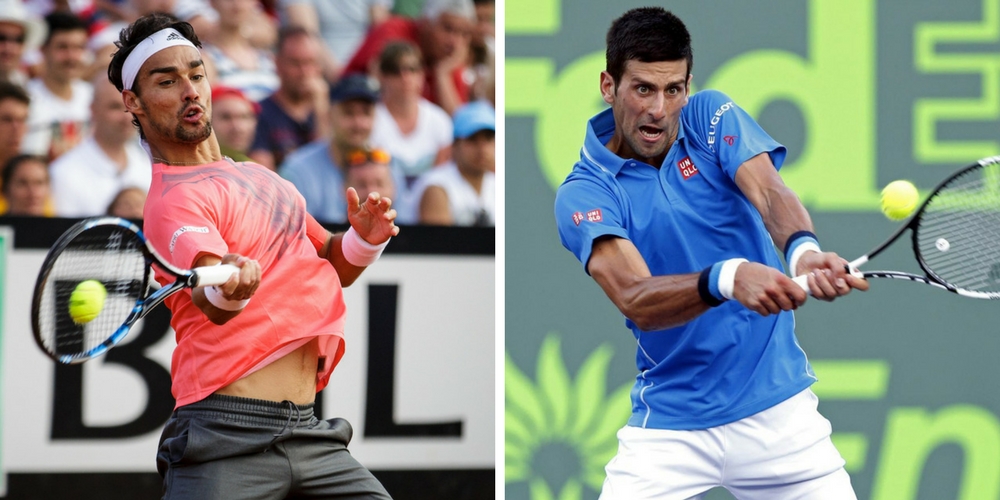
What is groundstroke in tennis? A groundstroke is a forehand or backhand stroke that is hit after the ball has bounced once on the court. It is one of the core fundamental shots in tennis and is normally played from the back of the court during a baseline rally. However, groundstrokes can be played from anywhere on the court so long as the tennis ball has bounced. So an approach shot hit from the middle of the court (around the service line) or even closer to the net is still considered a groundstroke. If the ball is hit in the air before bouncing it's a volley, drive volley or smash.
Unless you're watching footage from the 80's, 70's or earlier, groundstrokes are the most common type of stroke you see in tennis today. The modern game is dominated by "baseliners" like Nadal, Federer, Djokovic and Murray who battle it out from the back of the court with powerful forehands and backhands.
Generally, the forehand is the biggest weapon a player has during a rally from the baseline as it's usually capable of generating the most power. Compared to the forehand, the backhand groundstroke tends to be less powerful but is often the more consistent shot.
While there are some key differences between the two types of groundstrokes the fundamental mechanics stay the same. Power is generated and control maintained by balancing the right amount of rotation, up/down, forward/back and side-to-side movement during the stroke.
Like all strokes in tennis the forehand and backhand groundstrokes can be hit with a variety of different spins. These include, topspin, backspin or slice, flat and sidespin. What spin is used depends on the strategic situation but most commonly groundstrokes are hit with topspin.
Definition: What is a forehand groundstroke?
A tennis forehand is one of the two types of groundstrokes. It refers to a shot performed from the baseline with the racket held in your dominant hand. For a right-handed player the forehand swing starts on the right side of your body, continues forward and across your body as you contact the ball (at this point the palm of your hand is turned away from your body), and finishes on the left side of your body.
Beginner tips: How to hit a forehand step-by-step.
As with most strokes in tennis the forehand is hit on the move using a variety of different spins. For the purpose of this beginner guide I'm going to show you how to perform a topspin forehand from the baseline.
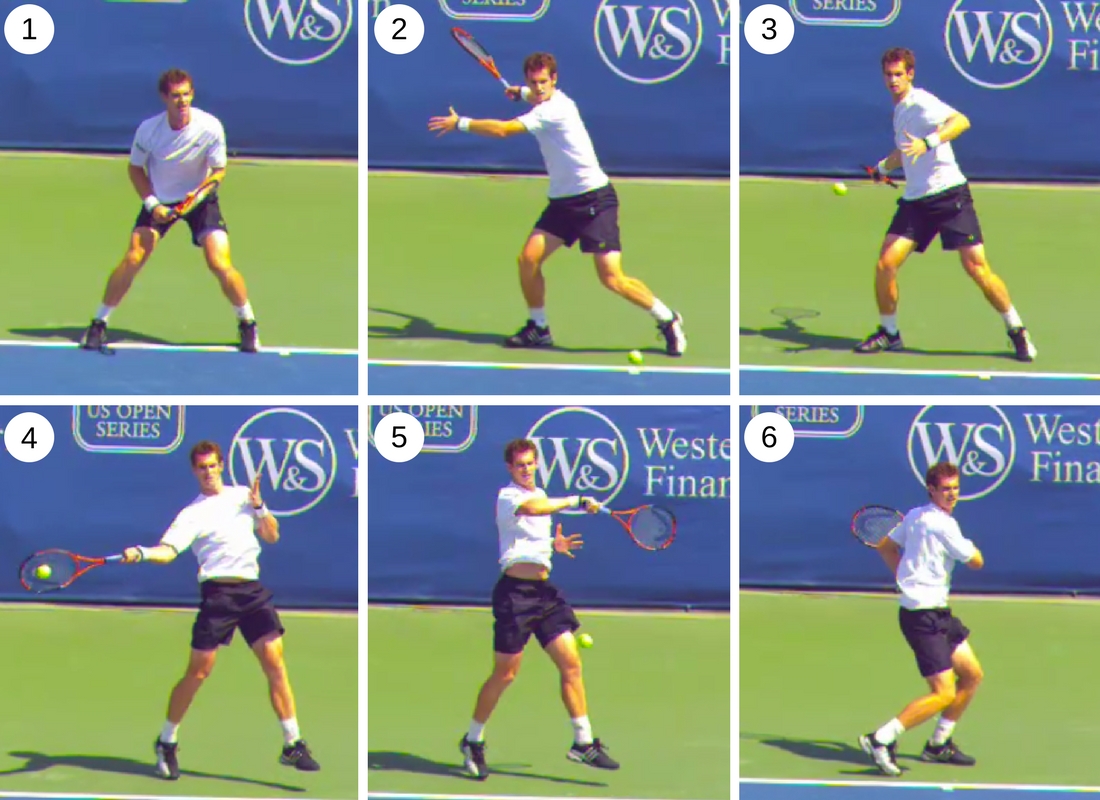
Here is how to hit a forehand groundstroke in six steps:
- Preparation. When your opponent makes contact with the tennis ball take light split step opening up your legs.
- As the ball approaches stay in that open stance position as you rotate your hips, shoulders and arms as part of the take back.
- Now start unwinding your body with your dominant arm dropping down (to help generate topspin) as it trails the rest of your body forward towards the ball.
- Continue rotating and swing your racket up, over and through the ball as you make contact. At this stage the front of your body and head should be facing the net.
- Follow through by continuing your arms extension forward then across your body towards your non-dominant side.
- Finally, complete your stroke with your weight shifted to your left leg (if right handed) and your racket head hovering around your left shoulder.
While practicing your forehand always try to maintain a "handshake" arm position with your right arm swing. That means not too cramped or too far away in relation to your body. This will help generate power while maintaining control. Also, remember that your wrist, hand and racket should be the last things to rotate through at contact point. In many ways the forehand is like a low serve as there are many similarities in body movement.
Definition: What is a backhand groundstroke?
A backhand in tennis is the other of the two types of groundstroke. It can be a one-handed and/or two-handed stroke. Like the forehand, the basic swing pattern starts on one side of your body, moves forward and across, and ends on the other side of your body. But unlike the forehand, the backhand is hit with the back of your dominant hand facing the direction of the stroke.
Beginner tips: How to hit a one-handed backhand step-by-step.
A one-handed backhand is performed with only your dominant hand holding the racquet grip as you make contact with the tennis ball. For the novice player, compared to the two-handed backhand the one-hander generally sacrifices some power and stability for greater reach. Look at this image sequence of Stan Wawrinka and follow along step-by step below.
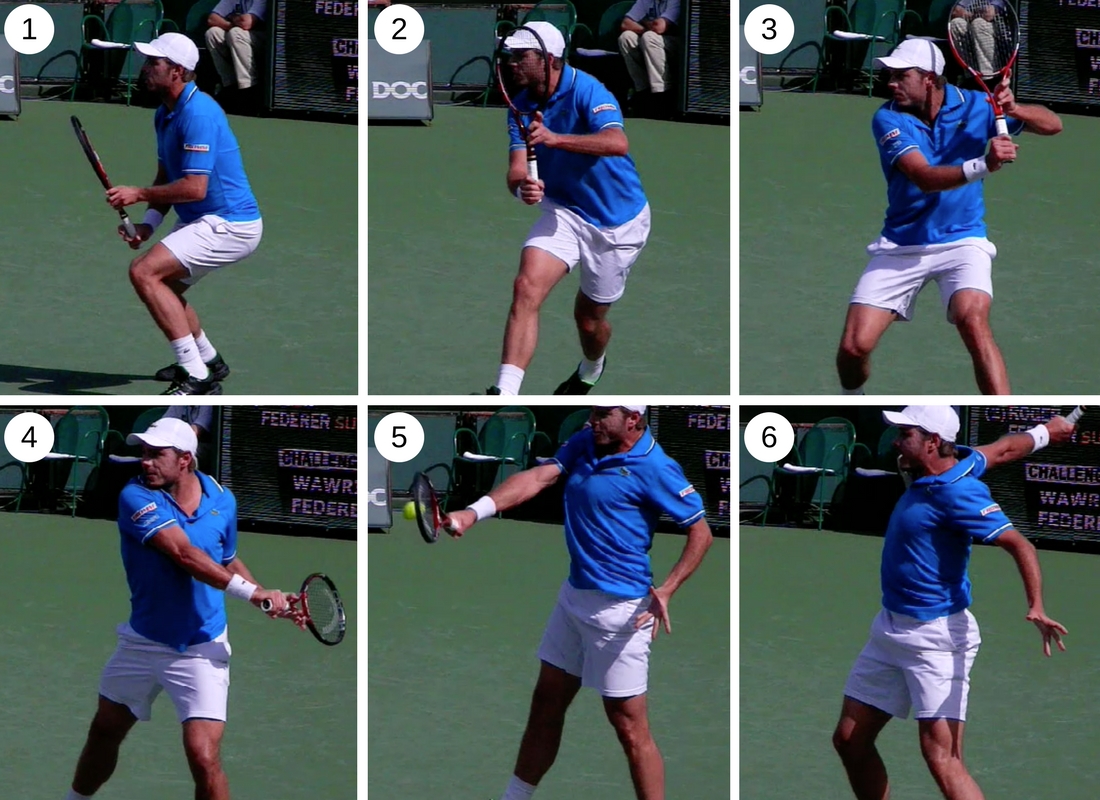
How to hit a one-handed backhand groundstroke in six steps:
- Take a light split step to get balanced and prepare.
- Move into position while at the same time begin rotating your upper body for the take back. It is generally easier to move your feet to a closed or side-on position to help with rotation and strength
- Once in position your take back should be done and your right shoulder pointing at the ball (if you're right handed).
- Just like the forehand, your arm will drop down as your start rotating and swinging towards the ball.
- As you continue to rotate back around (unwinding) your arm will whip forward and up making contact with the ball.
- Lastly, finish your backhand follow through by completing the motion and extending your arm to the right as you land with your weight primarily on your dominant side.
In the images sequence above Wawrinka has a relatively straight arm at contact point. You can however maintain a slight bend in your arm as this helps prevent injury. Remember, strive for simplicity, balance and a relaxed swing. Getting the basics right will lead to rapid improvements.
Beginner tips: How to hit a two-handed backhand step-by-step.
A two-handed backhand is performed with your dominant hand holding the bottom of the racquet grip and your non-dominant hand placed above as you make contact with the ball. The addition of the second arm and hand gives the two-handed backhand greater control and power at the cost of reach. Study the image sequence of Andre Agassi and follow along step-by step below.
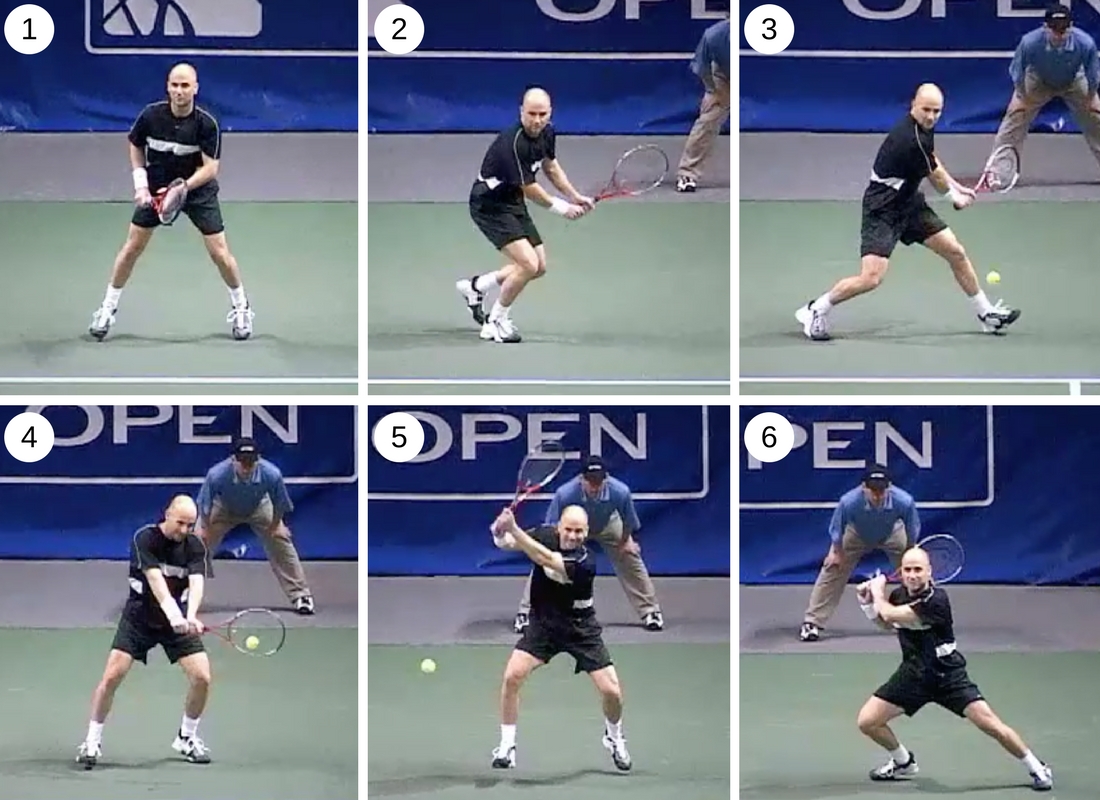
How to hit a two-handed backhand groundstroke in six steps:
- Split step as your opponent strikes the ball to get ready.
- Move into position while simultaneously taking the racket back.
- When in position your take back should be complete with your racket on your non-dominant side, shoulder angled towards the ball.
- Uncoil your body rotating your hips and shoulders to contact the ball. Here your body should be facing the net with approximately equal racket control given to both arms.
- As you follow through your left arm takes over driving through the ball.
- End your stroke by swinging your racket all the way to your non-dominant side with your bodyweight on your dominant side.
For a novice it can be helpful to think of the two-handed backhand as a left handed forehand but with an added arm for stability. While you grip the racket with both hands, how much control each arm has over the swing changes during the take back, contact point, and follow through from right arm, to equal control, and then left arm (if you're right handed). Keep this in mind when training. Also, note that in the image above Andre's feet are in an open stance as he's hitting the ball but a closed stance will also work fine in most occasions.
Tennis volley overview.
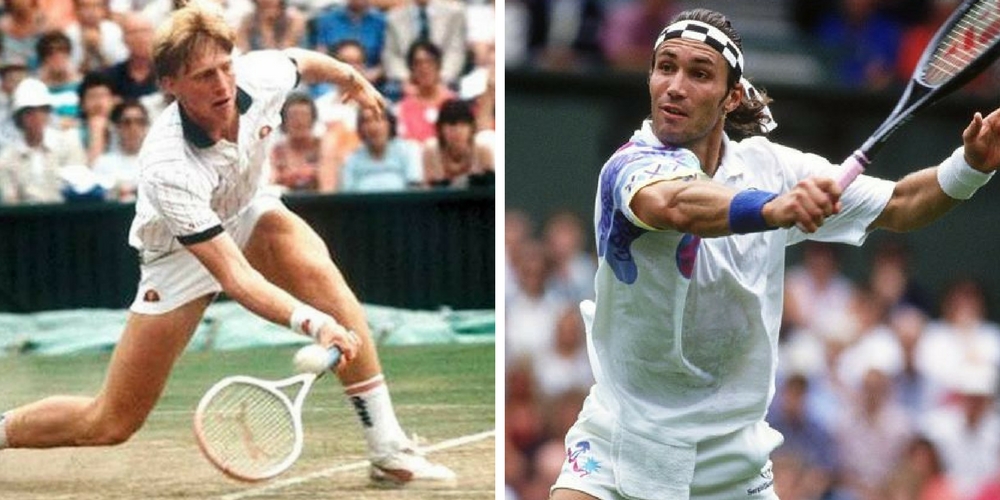
So what is a volley in tennis? A volley stroke is where the ball is hit out of the air before it bounces on the court. The term "volley" encompases both the forehand volley stroke and backhand volley stroke. Technically a volley can be played from just about any position but usually it's hit when a player is closer to the net. If the ball bounces before a player makes contact the shot is considered a groundstroke or half volley.
Volleying is an inherently offensive style of play as you're looking to aggressively shorten and win the point quickly by reducing the time your opponent has to react, move and recover from his/her previous position. Speed, reflexes, touch and good footwork are all required to become a great volleyer. This is because you have less time when you're close to the net so it's critical to shorten the backswing and follow through.
Definition: What is a forehand volley?
The forehand volley is one of the two types of volleys. It is generally played closer to the net than other strokes. Like the forehand groundstroke, a forehand volley is hit with the racket in your dominant hand palm facing away from your body. Again, similar to forehand groundstrokes, forehand volleys are hit with your dominant hand to the right side of your body if you're right handed, and to the left side of your body if you're left handed.
Beginner tips: How to hit a forehand volley step-by-step.
The key to a great forehand volley is explosive movement, simplified technique and good reaction. Remember the ball is coming at you fast and you don't have time for a big elaborate stroke. Look at the image below and notice how short Pete Sampras keeps his swing.

How to hit a forehand volley in four easy steps:
- When you approach the net keep your racket out in front and take a light split step to ready yourself as you move forward.
- As the ball approaches turn your upper body slightly to your right side taking the racket back.
- Continuing your forward momentum bring the racket forward maintaining a strong wrist and handshake arm position as you contact the ball.
- Keep moving your feet and body weight forward through the ball as you finish your follow through by swinging the racket back in front of your body.
When practicing either of your volleys think simple and minimal swing. Also, keeping your footwork and swing smooth is very important. Practice flowing through the ball using your bodyweight and forward momentum at and after contact point.
Definition: What is a backhand volley?
The backhand volley is the other type of volley. Just like the forehand volley it's usually hit quite close to the net. And similar to a single-handed backhand (aka one-handed backhand) groundstroke the backhand volley is hit using your dominant arm with the back of the hand facing away from your body as you grip the racket and make contact.
Beginner tips: How to hit a backhand volley step-by-step.
Just like the forehand volley, developing a solid backhand volley is as much about your footwork, momentum and body weight as it is about your swing. Explosive yet smooth movement to and through the ball is key.

How to hit a backhand volley in four easy steps:
- Approach the net quickly with your racket ready and out in front of you.
- As the ball comes towards you keep your technique simple with a short take back rotating your upper body to the left.
- Continue your forward momentum using your feed to move to the ball as you make contact with a short swing.
- Keep transferring your body weight forward through the ball and rotate your upper body slightly bringing the racket forward and to the right ending back in front of you.
Notice how short Tim Henman's actual swing is in the above image. Most of the work is being done by his legs. This is how you maintain control while generating power when attacking the net.
Tennis overhead smash overview.
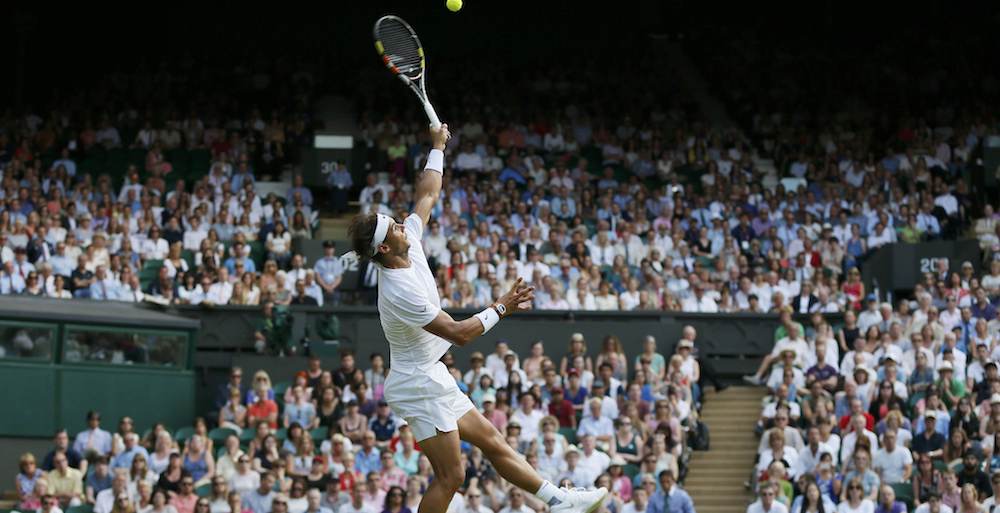
What is an overhead smash? In tennis an overhead smash is a stroke where the player contacts the ball with the racquet above his or her head using a serve-like motion. This shot is commonly referred to as simply a smash or overhead and the two terms are interchangeable. The term smash or overhead usually refers to the "forehand smash" or "forehand overhead" as this is the most common form of the shot. The backhand smash is only used when a player is unable maneuver into a position to hit the more powerful forehand smash.
An overhead smash is normally hit when a players is close to the net or around the middle of the court (around the service line) before the ball bounces. However, a player can elect to perform a smash "on the bounce". This is usually done because the opponent has thrown up a very high defensive lob. Letting the ball bounce once in this situation makes timing your smash correctly much easier.
Beginner tips: How to hit an overhead smash step-by-step.
You can think of the smash as portable serve. But unlike the serve, a smash is hit during the point while you are on the move. This means there are some very important differences. As you're running and moving during the rally, simplifying your technique and focusing on your footwork becomes incredibly important.

Here are five basic tennis tips for improving your overhead smash technique:
- Hold the racket using a continental grip.
- When you see the ball rising up through the air focus on your positioning keeping the ball in front of you at all times by using good quick footwork. While moving back, rotate your body bringing the racket straight back to a ready position with your non-dominant hand angled up towards the ball.
- As the ball drops into striking position uncoil and rotate your body swinging the racket up towards the tennis ball.
- Similar to the serve, at this point your body should have rotated to face your opponent as you snap your arm around making contact with the tennis ball.
- After contact continue with a short follow through bringing the racket down then across your body.
The basic overhead smash technique is similar in many ways to the serve but because you and the ball are moving around the court simultaneously your movement, simplicity and timing become extra important. A few additional tips are to A) practice shuffle steps, backpedaling, and crossover steps to move backwards with speed and balance, B) keep things simple by shortening your swing, and C) stay calm and relaxed as the ball drops down into your contact point zone.
Next steps.
I hope the above information has helped you better understand the game and that the beginner tips on technique will help kickstart your training. Remember that practice makes better and with time and proper instruction you'll develop consistent and powerful strokes you can feel confident in. So get out on the court and start hitting playing. For more advanced instruction you can download my free tennis coaching app and subscribe to my YouTube channel.
You might also like…
- The Correct Head Position for Better Tennis Technique
- What Makes a Tennis Champion? Natural Talent or Hard Work?
- How To "Watch The Ball" Like A Pro In Tennis
- The Greatest Forehand in Tennis
- Tennis Forehand Technique: Straight Arm vs Bent Arm
If you enjoyed this post please sign up for my newsletter. It's where I share member exclusive content not found anywhere else. Including interviews, my favourite gear, health & fitness exercises, tennis tips and more. Sign up here.
Source: https://www.patcash.co.uk/2018/03/the-6-basic-strokes-in-tennis-explained/
0 Response to "starts Doing Long Stokes With One Hand Continuing to Tug Towards the Bottom With the Other"
إرسال تعليق